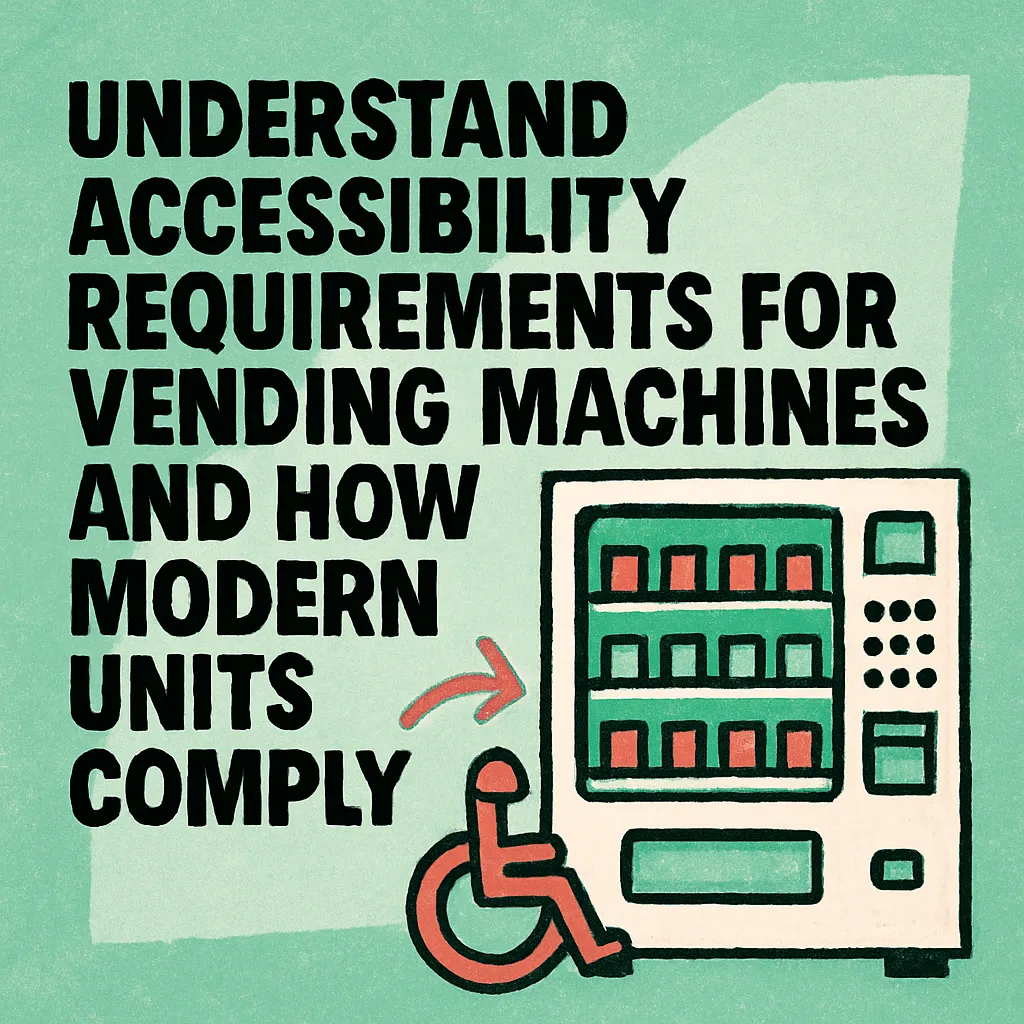Are Vending Machines ADA Compliant?
Understand accessibility requirements for vending machines and how modern units comply.
Back to Vending FAQs ResourcesUnderstand accessibility requirements for vending machines and how modern units comply.
Back to Vending FAQs ResourcesModern vending machines are increasingly designed to meet the Americans with Disabilities Act (ADA) guidelines, ensuring that snacks and beverages are accessible to all individuals, including those with mobility challenges.
![]() Vending controls within accessible reach ranges
Vending controls within accessible reach ranges
![]() Clear floor space for wheelchair maneuverability
Clear floor space for wheelchair maneuverability
![]() Operable payment systems for diverse users
Operable payment systems for diverse users

The Americans with Disabilities Act (ADA) sets forth comprehensive standards to ensure that individuals with disabilities have equal access to various facilities and services, including vending machines. When considering integrating vending machines into your business, understanding and adhering to these compliance requirements is not just a legal obligation but also a commitment to inclusivity.
ADA guidelines specifically address features like the height of operating controls, the force required to operate them, and the clear floor space available for wheelchair access. For instance, payment mechanisms, product selection buttons, and dispensing openings must be positioned within accessible reach ranges. This typically means maximum high-reach limits of 48 inches forward and 54 inches for side reach, ensuring that individuals using wheelchairs can comfortably interact with the machine.
Modern vending technology has made it easier to meet these standards. Many manufacturers design machines with adjustable components or pre-set configurations that comply with ADA regulations. Features like large, tactile buttons, clear visual displays, and ergonomic designs contribute to a more user-friendly experience for everyone. Furthermore, the placement of the machine is as crucial as the machine's design itself. Adequate clear floor space—a minimum of 30 inches by 48 inches—must be maintained in front of the machine to allow unrestricted access for wheelchair users, whether for a forward or parallel approach.
While meeting the basic ADA requirements is essential, some operators go further to enhance the experience. This might include ensuring machines are well-lit, clearly signed, and offering a variety of payment options, including cashless and mobile payment systems that are inherently more accessible. Regular maintenance also plays a role in compliance; a malfunctioning button or a blocked access path can render an otherwise compliant machine inaccessible. For facilities such as medical offices, ensuring wheelchair-accessible vending options is particularly vital.
Ensuring your vending machines are ADA compliant expands your customer base and reinforces your establishment's commitment to serving all members of the community equitably. By paying attention to both machine design and strategic placement, businesses can provide a convenient and inclusive service. Businesses interested in exploring ADA-compliant solutions can look into vending management companies who often have expertise in placement and machine selection to ensure compliance.
ADA compliance means vending machines must be accessible to individuals with disabilities, including those using wheelchairs. This covers aspects like reach range, operating controls, and clear floor space.
While many modern vending machines are designed with ADA guidelines in mind, it's crucial to confirm compliance for specific models and their installation to ensure full accessibility.
Operating controls, such as coin slots, bill acceptors, and selection buttons, must be within a maximum high forward reach of 48 inches and a maximum high side reach of 54 inches.
Yes, a clear floor space of at least 30 inches by 48 inches must be provided in front of the vending machine to allow for parallel or forward approach by a wheelchair user.
Payment systems, including card readers and keypads, must also be within the accessible reach ranges and operable without tight grasping, pinching, or twisting of the wrist.
Some older machines can be retrofitted with compliant components like modified dispensing chutes or lower control panels, but it often depends on the original design and cost-effectiveness.
Both the vending machine owner/operator and the facility owner where the machine is located share responsibility for ensuring ADA compliance. This helps guarantee an inclusive environment for all users.
Touchscreens must be designed to be accessible, often requiring alternative input methods like physical buttons, voice guidance, or height adjustability for different users.
Beyond legal requirements, ADA compliant vending ensures equal access for all customers, expands your potential customer base, and demonstrates a commitment to inclusivity, enhancing your reputation.
Detailed guidelines can be found on the Americans with Disabilities Act (ADA) website, particularly within the ADA Standards for Accessible Design, and through local accessibility codes.